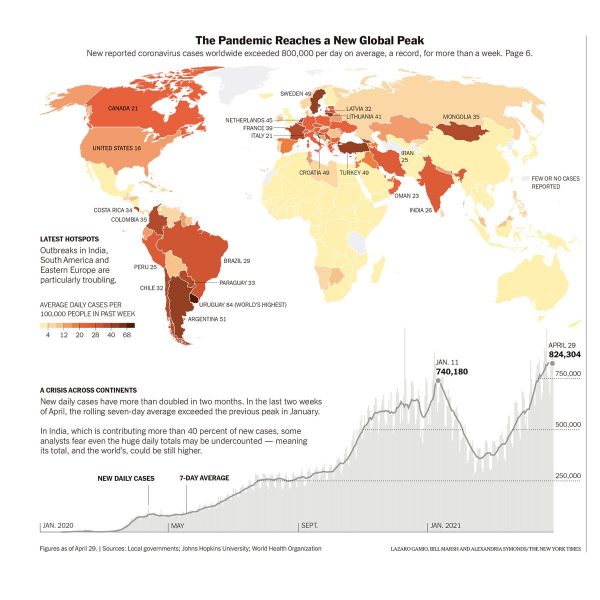The front page of the prestigious North American newspaper indicates South America as the main hot spot of spread and identifies Uruguay and Argentina as the most worrying cases. Then comes India, Turkey, and Sweden.

May 03, 2021, (INFOBAE).- The last seven days became dramatic for the spread of COVID-19, and The New York Times warns about the emergency with an eloquent map: in brown, almost black, the countries with the most infections per 100,000 inhabitants ou to date this week.
The newspaper warns that the daily average of new cases in the world has remained above 800,000 during the past seven days, and while the world looks to India, South America has the highest infection rate.
The country with the worst figures is Uruguay, which currently has the highest number of cases per capita in the world, is adding almost 3,000 cases a day, a staggering number in a country of just 3.5 million inhabitants. The map shows that in the last week Uruguay registered an average of 84 infections per 100,000 inhabitants.
Argentina follows, with a daily average of 22,763 new cases, a weekly average of 51 infections per 100,000 inhabitants.
In addition to the crisis in Uruguay and Argentina, Paraguay, Brazil, Peru, and Colombia are among the top 20 countries in the world in terms of COVID deaths per capita.
:quality(85)/cloudfront-us-east-1.images.arcpublishing.com/infobae/FGAVTLD4DZDTRLBWUSOMKLJGHQ.jpg)
Several factors have combined to fuel the outbreak in South America. In Brazil, the continent’s largest country, President Jair Bolsonaro’s dismissive attitude towards the threat posed by the virus has led to a month-long crisis, which has spread to neighboring nations. And early research has indicated that the P.1 variant, first identified in the Brazilian city of Manaus late last year, could be more transmissible and more deadly than previous forms of the virus.
Colombia’s second-largest city, Medellín, is also among the places where serious outbreaks are occurring. Last year, authorities were able to control the virus to a large extent. But a second and third wave, in January and April, have devastated the city. Although authorities added 1,000 new intensive care units in the region in 2020, that preparation has not been enough.
The cover article also warns about the situation in other countries of the world that, although their contagion rate per 100,000 inhabitants is lower than Uruguay and Argentina, they also have alarming rates: Sweden and Turkey, with 49 infections per 100,000 inhabitants each.
:quality(85)/cloudfront-us-east-1.images.arcpublishing.com/infobae/OWHRZHMAUNEQRGLWP7B4CJXEFM.jpg)
IN YELLOW COLOR SOUTH AMERICA COUNTRIES
Photo: (The New York Times)
India, today the country with the most media attention for the tragic images of the health collapse, is also on the map, with a rate of 26 infections per 100,000 inhabitants in the last seven days. While it doesn’t appear on the map as one of the most concerning cases, the NYT does explain that India is also driving this new global peak. It details that there, the seven-day moving average of new daily cases in the country exceeded 357,000 last Thursday, which represents an increase of more than five times since April 1. And it reveals that the country now accounts for more than 40% of the world’s new cases. Most concerning, the article warns, these grim numbers may be undervalued.
The second wave of the virus there has been devastating. In the hospitals of New Delhi, the capital, the shortage of medical oxygen has reached crisis levels, and the cremation grounds are working non-stop as family and friends continue to bring more corpses to burn. After enacting one of the strictest closures in the world last March, which kept deaths relatively low, Indian authorities relaxed restrictions. Some politicians even held massive rallies in recent weeks as the country’s infection rate soared. The increase has left hospitals overwhelmed.
“People are angry because they are not receiving respirators or oxygen,” said Dr. Rakesh Kumar, a doctor from the state of Uttar Pradesh, in northern India. “They say:‘ We are paying for the facilities; So why do our patients die? Medical professionals in India face a crushing situation. “No hospital has closed and no doctor has withdrawn from the front,” wrote a doctor in a Facebook post. “We are fighting the missiles with sticks, but we are not leaving the fort.”
Sources: INFOBAE / THE NEW YORK TIMES
